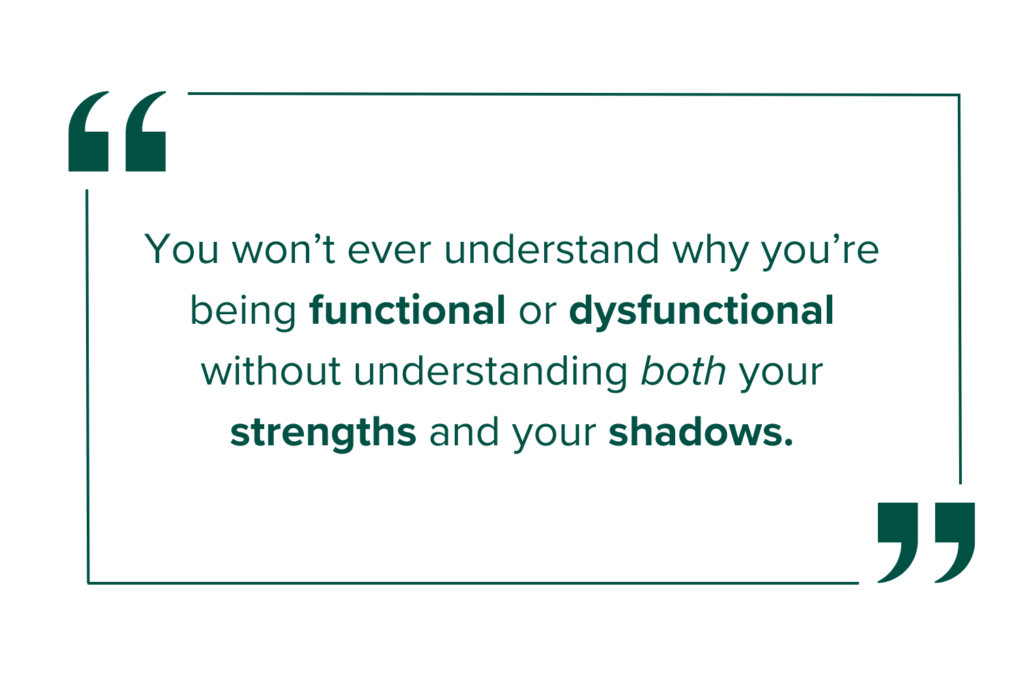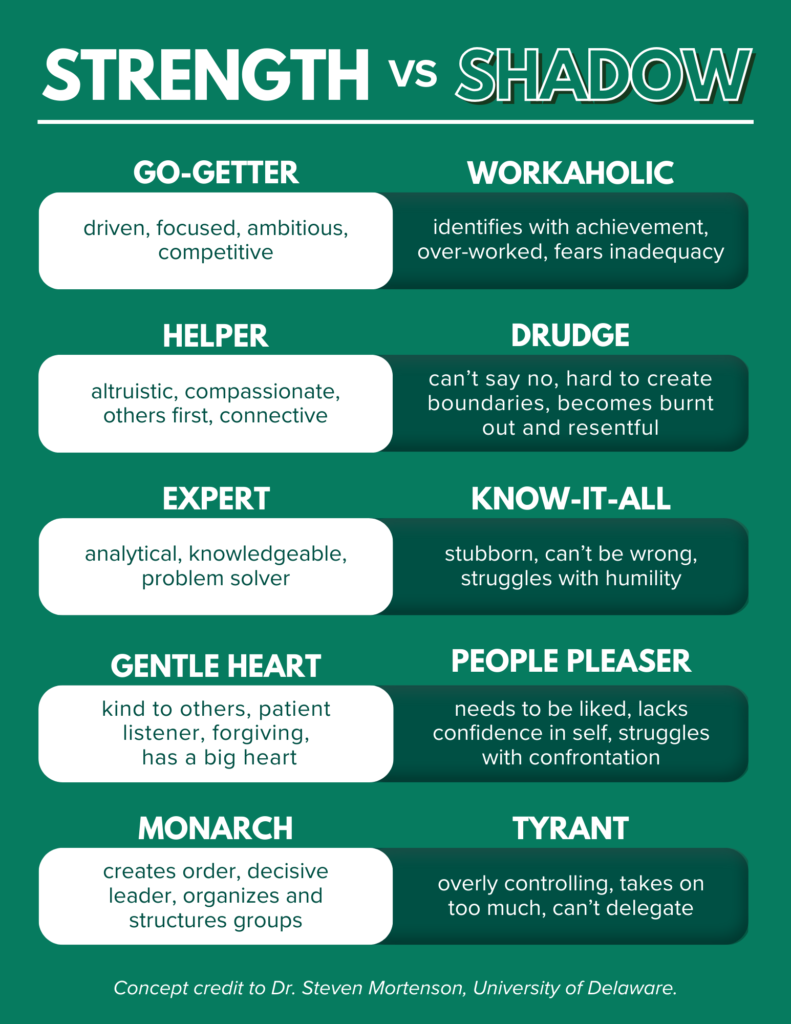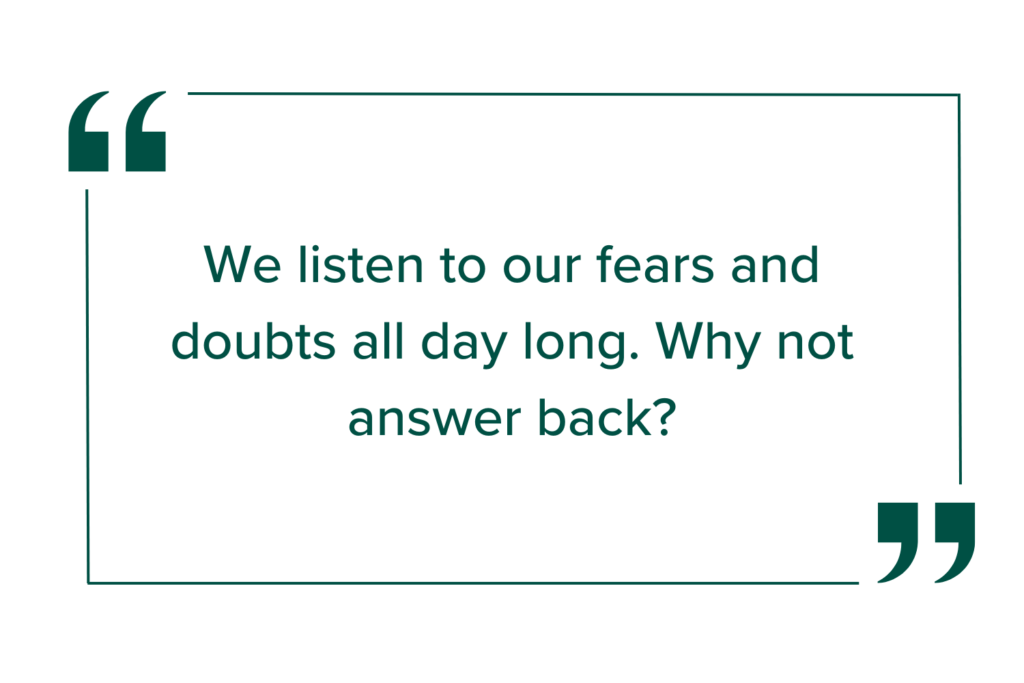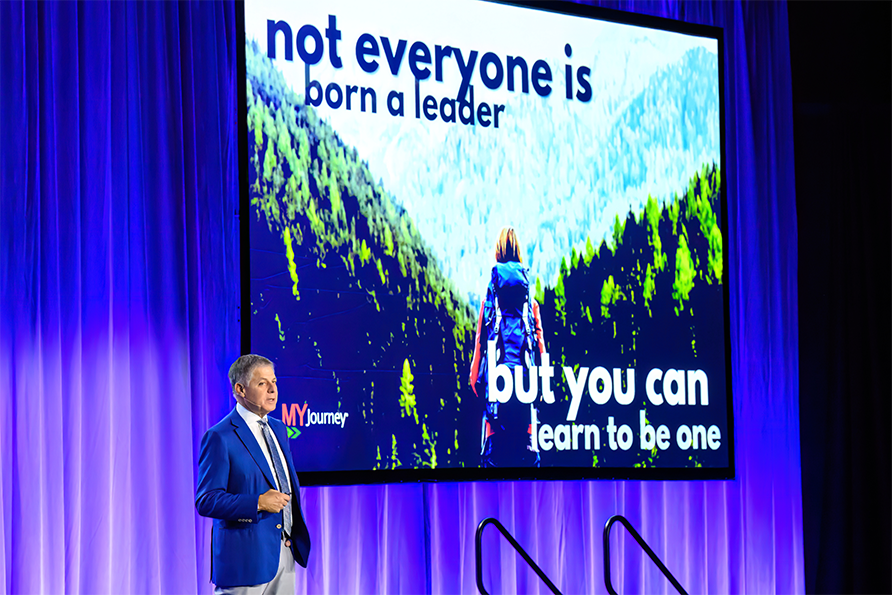As a team, there’s no better feeling than alignment – when your efforts as a group synergistically combine to produce something greater than what each member could achieve individually. But effective collaboration isn’t always easy, and too often, people find themselves unprepared to navigate their colleagues’ differing personalities and habits. This results in many professionals carrying heavier loads than they should due to stubborn independence or a dysfunctional team dynamic.
Dr. Steven Mortenson, Ph.D., an interpersonal communication professor and researcher at University of Delaware, has spent his career studying how people can enhance their interactions through an understanding of their own strengths and weaknesses. Using Carl Jung’s concept of the psychological shadow, Dr. Mortenson has found that by identifying and learning how to skillfully manage these divergent aspects of yourself, you can promote better personal and professional relationships with those around you.
“When it comes to collaboration and interacting with people in the workplace, one of the first things you do is take an inventory of your strengths. But it’s also important to know the dysfunctional side of these strengths, which Carl Jung called shadows,” Dr. Mortenson explained. “If you’re going to be working on a high-stakes project for a long time, you need to figure out who everyone is and who everyone is not. Then, you can really start to work together.”
This understanding is especially important given that our shadows come to the forefront in groups – particularly when we project our insecurities onto those around us. These projections can make working with others extremely difficult or, in some cases, nearly impossible. Having the courage to internally reflect and develop a deeper awareness of both your strengths and your shadows will lead to more authentic, synergistic, and productive collaboration.

Even strengths have their weaknesses
Think of an ability you have or a strength in your personality. What character ethic traits would you use to describe yourself? Are you a helper who prioritizes others above yourself? Are you a go-getter who derives great meaning from accomplishing your goals? You likely (and rightfully) take pride in these strengths – they make up who you are and how you present yourself to the world – but they aren’t all positive.
“Everyone is born with certain proclivities in their personalities,” said Dr. Mortenson. “Some people find themselves wanting to organize things. Other people naturally step into leadership positions. Others, when they see somebody upset or hurt, just instantly go to comfort them. But these proclivities come with dysfunctional tendencies as well, which are your shadows.”
Your strengths and your shadows are two sides of the same coin – if you have strengths, you also have shadows. For example, somebody whose strength is to be helpful and selfless might not be able to prioritize self-care or say ‘no.’ The go-getter, who is incredibly ambitious and driven, might struggle with feelings of inadequacy or have a shadow around relaxation. These shadows are unavoidable, but they can be managed with attention and practice.
“If you pretend that all you need to do is keep and increase the strengths that you already have, then your strengths will turn toxic and you won’t truly develop as a person,” Dr. Mortenson elaborated. “You won’t ever understand why you’re being functional or dysfunctional without understanding both your strengths and your shadows.”

Recognizing your shadow projections
Our shadows – the toxic sides of our strengths – tend to reveal themselves in groups, when others remind us of these shameful, unwanted, or feared parts of ourselves. Carl Jung called this shadow projection.
“Think of a time when you found yourself on the defense, irritated, or angry in situations where others are relaxed,” Dr. Mortenson offered. “Have you recently become angry with someone who hasn’t actually done anything wrong? Do you have coworkers who get under your skin for no particular reason? Perhaps, this is your shadow being activated.”
These often-disproportionate reactions to otherwise very normal behavior from your peers can inhibit connections and stifle collaboration if you don’t know why they are happening and how to manage them. “When our shadows pop up at work, they destabilize us,” explained Dr. Mortenson. “We get hijacked, and we become less comfortable in our skin. We harbor more anger and aggression, and we become dysfunctional.”
This is why it’s important to recognize not only what your shadows are but also when they become activated. There are three common types of shadow projections that might occur when someone reminds us of a denied piece of ourselves:
- Projecting an unwanted trait that we refuse to admit to.
- Projecting our own self-criticisms.
- Projecting our unmet needs.
Looking back at our examples – when a coworker does something self-serving or sets boundaries instead of dropping everything to help another, the always-helpful person may view this coworker as greedy or selfish. This reaction could be a result of the helper’s unwanted view of themselves as self-serving, their insecurity about their own need for self-care, or their repressed need for saying ‘no.’
Additionally, when a colleague takes a break or does not work overtime, the consistently ambitious go-getter might see this person as lazy. This over-exaggerated projection could also be a result of the go-getter’s negative self-view, or their secret desire to take a break.
Real, authentic anger and frustration require an actual transgression to take place. So, when you find yourself feeling negatively toward someone who has not crossed or wronged you, it’s likely that one of these three forms of shadow projection is taking place.

Taking control of your emotions
Once you’ve identified the types of people and situations that activate your shadow, you can learn how to diffuse your triggers as they’re happening. And through a simple moment of honesty and humility, you can see great improvements in how you interact and work with those around you.
According to Dr. Mortenson, diffusing a shadow trigger breaks down into four steps:
- Pay attention to the emotion that you’re feeling. “Ask yourself, ‘Am I too angry, defensive, aggressive, etc. about this? Did the other person intentionally make me upset?’ Probably not.” By becoming aware of surges in your emotions that are disproportionate to the situation at hand, you can recognize that a shadow has been triggered and work to diminish its effect.
- Figure out which part of your shadow is being activated. “Consider, ‘Why am I worked up right now? Is it my helper who doesn’t want to be seen as self-centered? Is it my go-getter who really needs a break?’ By identifying the part of you that’s hijacked, you can face the shadow head-on and shrink it down,” said Dr. Mortenson.
- Call out your shadow – talk to and challenge your emotions. “We listen to our fears and doubts all day long. Why not answer back?” Dr. Mortenson challenged. For the go-getter annoyed at their colleague who takes too many breaks, this might sound something like, ‘That person isn’t lazy. Taking breaks is an unmet need of mine, and I’m jealous that they can step back and take one.’
- Consider your response. Your overly emotional initial response probably no longer fits. So, what does? “Is it talking to someone, is it apologizing, or is it just doing nothing?” Dr. Mortenson asked. “A lot of the time, your response is going to be simply relaxing, holding back your initial reaction, and recognizing that your emotions are just your shadow working you up.”
If you can follow these four simple steps when difficult situations or people trigger your shadow, then you can accept that your coworkers might function differently than you do. By tempering your reaction to your shadow projections and refusing to take other people’s personalities personally, you can promote the healthy working relationships that drive enhanced collaboration.

Strengthening your team environments by improving yourself
At Siegfried, we’re all about transformation, and growth-oriented people are constantly developing new strengths. However, this means that they’re also developing new shadows.
To truly feel aligned when collaborating with others, you must be aware of your strengths’ shadows, the specific situations or people that trigger them, and the ways in which you can reevaluate your emotional response to these triggers.
Making the effort to look inward and evaluate your personal strengths and shadows requires courage and vulnerability – traits that could be difficult to embody, especially when it comes to the workplace. But the result is greater connections, greater growth, and greater success, for both yourself and those around you.









